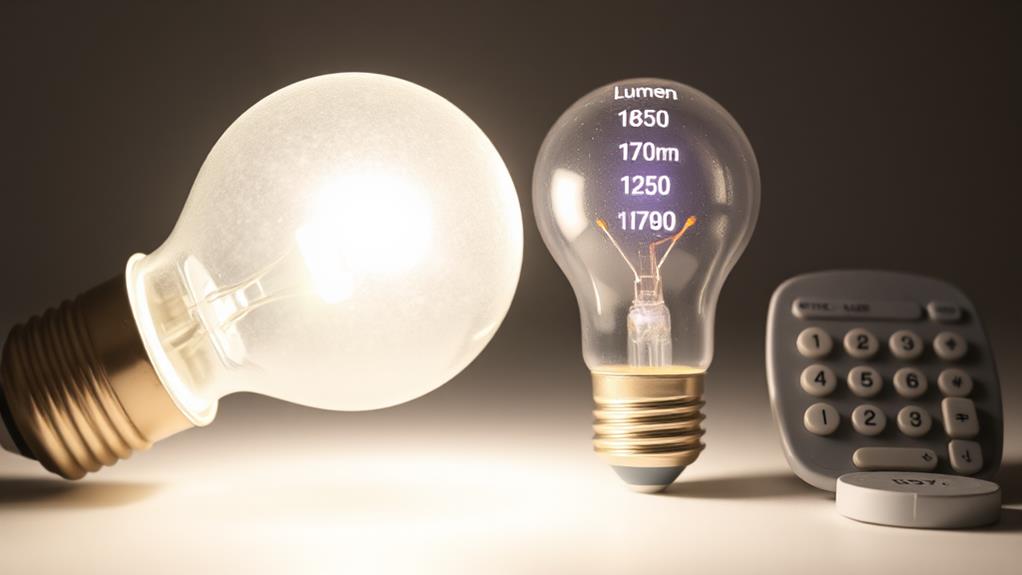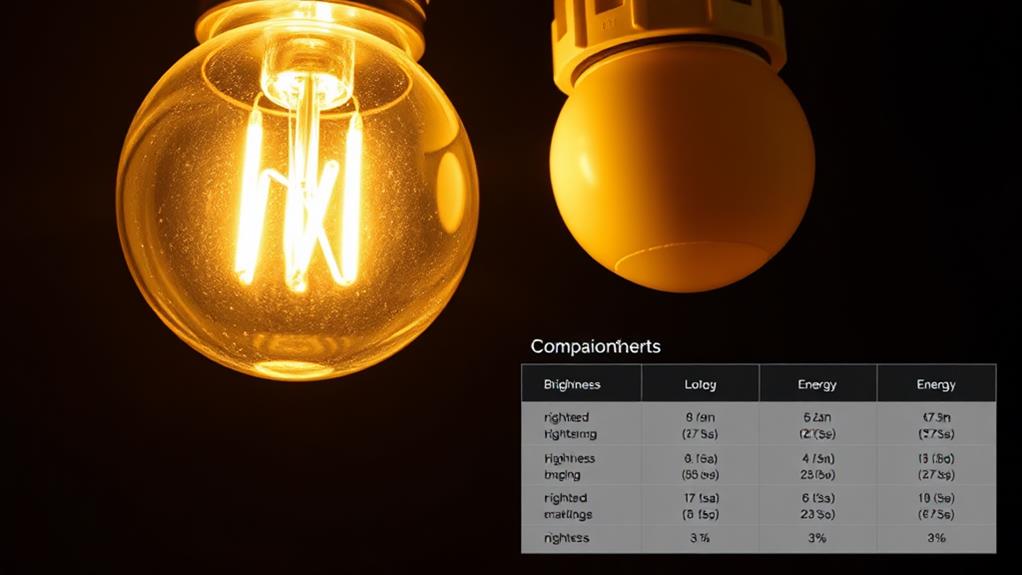Lumens measure light output, while watts measure energy consumption. In modern lighting, lumens are more important for determining brightness. Higher lumen counts mean brighter light. The shift to lumen-based measurements is due to energy-efficient technologies like LEDs, where wattage doesn't reliably indicate brightness. To calculate the right brightness for a space, multiply square footage by recommended lumens per square foot. LED bulbs offer the best balance of energy efficiency and brightness, with higher lumens-per-watt ratios. When choosing a bulb, consider desired brightness in lumens, color temperature, and fixture compatibility. Understanding these concepts will help you make smarter lighting choices for your home.
Defining Lumens and Watts

When you're shopping for light bulbs, you'll often encounter two key terms: lumens and watts. It's essential to understand the difference between these two measurements to make informed lighting decisions.
Lumens measure the amount of light emitted by a bulb. They represent the brightness or light output that you'll actually see. The higher the lumen count, the brighter the light. For instance, a bulb with 800 lumens will produce more visible light than one with 400 lumens.
Watts, on the other hand, measure energy consumption. They indicate how much electricity a bulb uses, not its brightness. In the past, watts were used as a proxy for brightness in incandescent bulbs, but this correlation doesn't hold true for modern, energy-efficient lighting technologies like LEDs.
To put it simply: lumens are about light output, while watts are about power input. When you're selecting a bulb, focus on the lumen rating to ensure you're getting the desired brightness. The wattage is still important, but mainly for understanding energy efficiency and calculating electricity costs. By prioritizing lumens over watts, you'll choose bulbs that provide the right amount of light for your needs while potentially saving energy.
The Shift to Lumen-Based Measurements
Over the past decade, the lighting industry has undergone a significant transformation in how it communicates brightness to consumers. You've likely noticed this change when shopping for light bulbs. Instead of focusing on watts, manufacturers now emphasize lumens as the primary measure of brightness.
This shift to lumen-based measurements was driven by the rise of energy-efficient lighting technologies, such as LEDs and CFLs. These new bulbs produce more light with less energy, making wattage an unreliable indicator of brightness. By adopting lumens, you can now compare different types of bulbs more accurately.
The transition hasn't been without challenges. Many consumers are still accustomed to thinking in terms of watts, and it's taken time for people to understand and embrace the lumen system. To ease this transition, you'll often find packaging that includes both lumens and "watt equivalents" to help you make informed choices.
As you become more familiar with lumens, you'll find it easier to select the right bulbs for your needs. This shift empowers you to make more energy-efficient lighting choices while ensuring you get the brightness you desire.
Calculating Brightness With Lumens

A simple formula can help you calculate the right brightness for your space using lumens. Multiply the square footage of your room by the recommended lumens per square foot for the room's purpose. For example, a living room typically needs 10-20 lumens per square foot, while a kitchen might require 30-40 lumens per square foot.
To put this into practice, let's say you have a 200 square foot living room. Multiplying 200 by 15 (an average for living rooms) gives you 3,000 lumens. This means you'll want light fixtures or bulbs that collectively produce about 3,000 lumens to adequately illuminate the space.
Energy Efficiency and Light Output
Energy efficiency goes hand in hand with light output when choosing modern lighting solutions. You'll find that LED bulbs offer the best balance between energy consumption and brightness. These bulbs use significantly less power than traditional incandescent or even CFL options while providing the same or better illumination.
When comparing bulbs, look at the lumens-per-watt ratio. This measure tells you how much light you're getting for the energy used. Higher ratios indicate more efficient bulbs. For example, a 60-watt equivalent LED bulb might produce 800 lumens while consuming only 9 watts, giving it a ratio of about 89 lumens per watt. In contrast, a traditional 60-watt incandescent bulb produces the same 800 lumens, resulting in a much lower ratio of 13 lumens per watt.
Choosing the Right Bulb

Selecting the ideal bulb for your lighting needs requires careful consideration of several factors. First, determine the desired brightness in lumens for the space you're illuminating. For a living room, you might want 1,500-3,000 lumens, while a bedroom may only need 1,000-2,000 lumens.
Next, consider the color temperature. Warm white (2700-3000K) creates a cozy atmosphere, while cool white (3500-4100K) is better for task lighting. Daylight (5000-6500K) is ideal for reading or detailed work.
Don't forget about the bulb's shape and base type. Ensure it fits your fixture and provides the desired light distribution. For example, A19 bulbs are common for general use, while BR30s are perfect for recessed lighting.
Energy efficiency is crucial, so look for ENERGY STAR certified bulbs. These use less energy and last longer than traditional incandescents. LED bulbs are typically the most efficient option, offering significant energy savings over their lifespan.
Conclusion
Now that you've illuminated your understanding of lumens and watts, you're equipped to make brighter choices for your lighting needs. Remember, lumens are your guiding light when it comes to brightness, while watts tell the energy efficiency tale. As you navigate the dazzling world of modern lighting, don't be left in the dark. Embrace the lumen revolution and let your newfound knowledge shine through in every bulb you choose.

